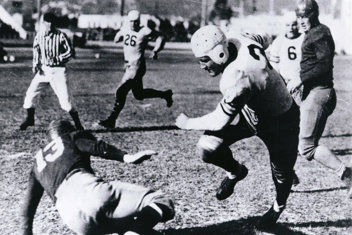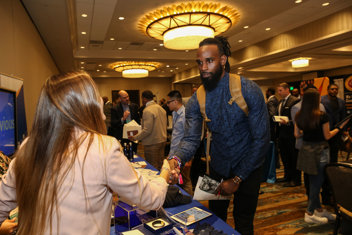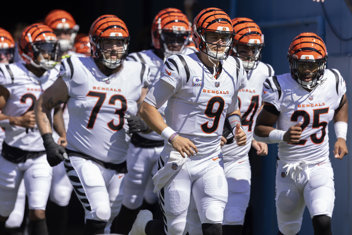Together with the NFLPA, the NFL works to ensure players receive medical care and that policies and protocols are informed by input from medical experts.
The National Football League is committed to advancing progress in the diagnosis, prevention and treatment of sports-related injuries, enhancing medical protocols, improving how the game is taught and played, and protecting players’ overall health, safety and wellbeing.
PROTECTING PLAYERS
The NFL enforces rules changes aimed at eliminating potentially risky behavior that could lead to injuries. The Competition Committee, which spearheads the rules-changing process, reviews injury data after every season and examines video to see how injuries occur. More than a dozen NFL health and safety committees, subcommittees and panels provide input, as does the NFL Players Association. The Player Safety Advisory Panel submits formal recommendations directly to the Competition Committee and the Commissioner. Their analysis covers all injuries impacting players, including concussions and ACL/MCL tears, and considers how protocols and rules changes are making an impact on player safety.
Applied Analytics: Use of the Helmet Rule
Through rules changes, such as kickoff modifications and the "Use of the Helmet" rule — which states that it is a foul if a player lowers his head to initiate and make contact with his helmet against an opponent — the NFL is leveraging data in an effort to improve player safety and evolve the game.
For the “Use of the Helmet” rule change, for example, the comprehensive review of data and video led by the NFL’s medical and engineering advisors suggested that there may be an increased risk associated with lowering the head to align the neck and spine to initiate and make contact with the helmet. Accordingly, the clubs unanimously agreed to a rule change aimed at reducing that risk.
The review also showed that over the course of all games during the 2015-2017 seasons, the kickoff represented only six percent of plays but 12 percent of concussions. Data suggested that players had approximately four times the risk of concussion on the kickoff compared to running or passing plays. Accordingly, modifications to the kickoff rule addressed the components that were understood to pose the most risk, like the use of a two-man wedge, while maintaining the play. The Competition Committee worked with special teams coaches and NFL medical and engineering advisors to consider changes to the kickoff play during an owners and coaches session in early May. NFL clubs approved the Competition Committee’s proposal later that month during the Spring League Meeting.
The NFL and the NFLPA work together to protect players by outlining infractions or penalties for improper player conduct, dangerous plays or incorrect use of safety equipment. For example, the NFL requires players to wear thigh and knee pads during games to better protect them from leg injuries. As with helmets and shoulder pads, players not wearing the mandatory protective equipment are not permitted onto the playing field and may be fined.
Additionally, the league mandates the proper maintenance and testing of playing fields to reduce the risk of injury. In 2016, the NFL and NFLPA established the Field Surface Safety & Performance Committee to perform research and advise on injury prevention, improve testing methods and adopt tools and techniques to evaluate field surface performance and playability. It also oversees the NFL stadium inspection program, which includes testing of NFL playing surfaces by engineers retained by the NFL, under observation by NFLPA experts.
EVOLUTION OF EQUIPMENT
Each year, helmets undergo laboratory testing by biomechanical engineers appointed by the NFL and the NFL Players Association to evaluate which helmets best reduce head impact severity. The results of the laboratory tests are displayed on a poster and shared with NFL players, club equipment managers, as well as club medical, training and coaching staffs to help inform equipment choices. In 2021, the NFL and NFLPA prohibited three additional helmet models from being worn by NFL players. Moving players into better performing helmets is an important step toward reducing injuries, and it reflects the strong collaboration between the NFL and NFLPA to promote player safety. (Note: Laboratory test conditions are intended to represent potentially concussive head impacts in the NFL. Results of this study should not be extrapolated to collegiate, high school, or youth football.)
The Right Fit: Evaluating Helmet Performance
THE TEAM BEHIND THE TEAM
On average, there are 30 healthcare providers at a stadium on game day to give immediate care to players. In conjunction with the NFLPA, the league uses unaffiliated medical personnel to assist in the identification and review of injuries, with a specific focus on concussions.
NFL medical professionals follow the step-by-step NFL Concussion Protocol when they are identifying, diagnosing and treating player concussions. The NFL Head, Neck and Spine Committee — a board of independent and NFL-affiliated physicians and scientists, including advisors for the NFL Players Association — developed the NFL Game Day Concussion Diagnosis and Management Protocol in 2011.
NFL medical professionals follow the NFL Concussion Protocol when identifying, diagnosing and treating player concussions. The Concussion Protocol, developed in 2011, is reviewed and revised each year to ensure that care reflects the most up-to-date medical information.
To ensure consistent implementation of the protocol, the NFL and NFLPA developed an enforcement policy, which includes a process to investigate clubs that fail to follow the protocol and determine appropriate discipline – including fines and possible forfeiture of draft picks.
INJURY REDUCTION PLAN
After a 16 percent year-over-year increase in concussions during the 2017 season, NFL Chief Medical Officer Dr. Allen Sills issued a call-to-action to reduce concussions. The result was the Injury Reduction Plan, a three-pronged approach to drive behavioral changes:
A foundational element of the NFL’s approach to player health and safety is data collection and analysis, which helps reduce and prevent player injuries. Recent innovation in player equipment – including sensors in mouthguards and shoulder pads – provides the league with data that informs advances in equipment, training and how the game is played, leading to a safer and more exciting game.
- Preseason Practices: The NFL shares information across the league to educate, stimulate change and enhance player safety—including information about concussions in preseason practices. The time during the preseason, the drill, the player position and how each club's injury data compare to the rest of the league are just some of the information shared with each club. Clubs have been asked to review practice schedules and monitor contact drills, particularly in the early weeks of training camp.
- Better Performing Helmets: Each year, helmets undergo laboratory testing by biomechanical engineers appointed by the NFL and the NFL Players Association to evaluate which helmets best reduce head impact severity. The results of the laboratory tests are displayed on a poster and shared with NFL players, club equipment managers, as well as club medical, training and coaching staffs to help inform equipment choices. In 2021, the NFL and NFLPA prohibited three additional helmet models from being worn by NFL players. Moving players into better performing helmets is an important step toward reducing injuries, and it reflects the strong collaboration between the NFL and NFLPA to promote player safety. (Note: Laboratory test conditions are intended to represent potentially concussive head impacts in the NFL. Results of this study should not be extrapolated to collegiate, high school, or youth football.)
- Rules Changes: The third component is the enforcement of rules changes aimed at eliminating potentially risky behavior that could lead to injuries. Through the latest changes, including defenseless player protection during kickoff and emphasizing certain illegal techniques from line play, such as using the helmet as part of a bull rush, or any block by an offensive lineman that involves initiating contact with the helmet—the NFL is leveraging data in an effort to improve player safety and evolve the game.
- These efforts have contributed to a sustained 25% reduction in concussions for the last three seasons, 2018-2020.
MEDICAL RESEARCH
The NFL supports preeminent experts and institutions in their research on the diagnosis, treatment and prevention of sports-related injuries and other issues affecting NFL players’ health, safety and wellbeing.
NFL Scientific Advisory Board: In 2016, the NFL allotted $40 million for medical research primarily dedicated to neuroscience. The NFL assembled a Scientific Advisory Board (SAB)—chaired by Peter Chiarelli, U.S. Army General (Retired)—comprising leading independent researchers, experts, doctors, scientists and clinicians to identify and support research proposals on the diagnosis, treatment and natural history of concussion and associated comorbid conditions.
In 2018, the SAB granted $35 million in total funding to five projects for research being conducted by investigative teams related to the diagnosis, treatment, and natural history of concussion (mild traumatic brain injury) and associated comorbid conditions.
In July 2021, the SAB announced a four-year, $4 million award to a team of medical researchers led by the University of Wisconsin who are investigating the prevention and treatment of hamstring injuries in elite football players.
The remaining $1 million in SAB funding will be awarded through a request for proposals for research on alternatives to opioids for pain management.
Learn more about the NFL’s support for medical research.



